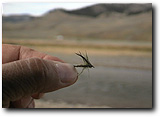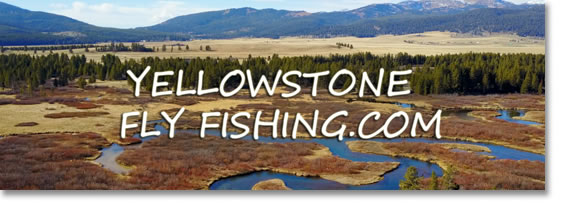Mayflies
Mayflies can be found emerging every month
of the year in the Yellowstone area. They are particularly abundant from
May through October and are an important food source for trout during
this time period. Mayflies are responsible for many of the great fly fishing
opportunities that arise during the season, and a knowledge of their habits
is invaluable for an angler.
 Mayflies
inhabit every trout stream and the number of species a stream can hold
is often amazing. Our friend Dan Gustafson has found over sixty species
on the Gallatin River alone, a sign of remarkable diversity in habitat.
Of course not all rivers support so many species, and not all species
are important to fly fishermen. Some mayflies are not abundant enough
to warrant individual concern, while other species are so closely related
in behavior that they can be considered synonymous by fishermen. Other
mayflies are simply not available to trout in quantities large enough
to require any attention from fishermen. Mayflies
inhabit every trout stream and the number of species a stream can hold
is often amazing. Our friend Dan Gustafson has found over sixty species
on the Gallatin River alone, a sign of remarkable diversity in habitat.
Of course not all rivers support so many species, and not all species
are important to fly fishermen. Some mayflies are not abundant enough
to warrant individual concern, while other species are so closely related
in behavior that they can be considered synonymous by fishermen. Other
mayflies are simply not available to trout in quantities large enough
to require any attention from fishermen.
The species we discuss are responsible
for virtually all of a Yellowstone angler's mayfly fishing. The list
is actually quite short, and if you do not fish certain rivers or at
certain times of the year, the list shrinks even more.
While each species has its own peculiarities,
most demonstrate a preference for similar emergence and egglaying conditions.
Knowing when the best mayfly activity will occur is as important as
knowing the individual traits of a given species.
The heaviest mayfly emergences generally
take place in overcast, cool weather. Misting rain or snow showers are
ideal and stir the blood of all fly fishermen aware of this fact.
Though we can find no substantiation
for this theory among professional entomologists, every experienced
angler we know is in agreement on this point. Entomologists tell us
that mayflies may actually prefer warm, dry conditions, and that they
hatch just as abundantly on those kinds of days. We've been told cool
weather simply concentrates the emergence over a short time period,
and that during warm, dry days just as many mayflies emerge but do so
by trickling off over longer periods.
We have trouble accepting that theory
because it runs counter to years of observation by so many people. While
inclement weather is not a strict requirement for good hatches (we have
all seen great emergences on nice days), there is no doubt in our minds
that many more flies come off when the weather is bad.
Of one thing we are sure: the
best fishing during mayfly hatches is definitely on days when
the weather is poor. If not because there are more mayflies, then certainly
because they ride the water longer in cool weather, and suffer more
emergence defects. Both these factors give the fish a better chance
to feed on them. Too, trout in general (and browns specifically) seem
to feel more comfortable feeding under overcast sides. This makes approaching
and casting to them easier.
Of the mayfly spinners important to fishermen,
all need moderately warm, calm conditions to lay their eggs. Wind stronger
than a slight breeze, cold temperatures, or any precipitation precludes
the spinners from reaching the water. Attention to the weather then,
as well as learning the habits of the prevailing mayflies, can be very
important to successfully fishing Yellowstone mayfly activity.
Mayflies are most vulnerable and available to trout while hatching and
during egg laying and subsequent spinner falls.
Hatches
Baetis (Blue-Winged Olives, or BWOs) emerge best from I I A.M. to 4 P.M.
on overcast, rainy, or snowy days. The cooler the day, the later the
hatch.
Rhithrogena spinners are sometimes important on calm, warm evenings during July
and August.
Pale Morning Duns (PMDs) generally emerge at the most comfortable time of day: noon
to I P.M. on snowy days; 9 to 11 A.M. on sunny, warm days. Spinner
falls are best on cairn, warm mornings, 9 to 11 A.M., and ag?in during
the evening, 7 to 10 P.M.
Green Drakes emerge from 10 A.M. to I P.M. Fall Green Drakes come off from I to
4 P.M. Spinner falls (seldom encountered) occur from 7 to 9 A.M.
Brown Drakes hatch from 71010 P.M.; spinner falls coincide with emergences.
Flavs emerge on clear days from
8 to 9 P.M. In cloudy, rainy conditions look for them from I P.M.
on. Spinner falls occur from 7 to 9 p.m.
Gray Drakes on Slough Creek
emerge sporadically all day long, beginning as early as 8 A.M. Spinner
activity is better coordinated and goes from 9 A.M. until noon. On
the Yellowstone River, spinner falls occur twice each day, 8 to 10
A.M. and 7 to 9 P.M.
Callibaetis duns emerge
on lakes from 10 A.M. to 2 P.M.; spinner falls occur from 11 A.M.
to 3 p.m.
Tricorythodesshow on
the Madison River between 10 A.M. and noon; spinners are more important
than duns.
Pink Ladies hatch from
4 to 7 P.M.
Attenella margarita duns and spinners can appear together from 9 to 11 A.M. Spinners
may fall on warm, calm evenings as well.
Serratella tibialis duns come off between II A.M. and 3 P.M., with spinner falls from
7 to 9 P.M.
Heptagenia duns, when found, emerge between I and 5 P.M. Spinners fall best on
warm, calm evenings.
Caddis emerge best on warm, calm evenings. Egg-laying activity usually occurs
at the same time. However, in their peak periods caddis may also be
found laying eggs in the morning. Trout recognize both emerging and
egg-laying periods and feed best during these two events. There are
two important exceptions to this:
Lepidostoma on the Gibbon River often emerge during the early afternoon on cloudy
days.
Hesperophylax caddis on the Yellowstone River usually
emerge from 8 to 9 A.M.
Stoneflies, such as the Salmonfly and Golden Stonefly, have their
strongest egg-laying periods on warm, windy, sunny days from 10 A.M.
to 6 P.M. These clumsy fliers are most available to trout when they
bounce on the water while depositing their eggs.
Little Yellow Stones lay eggs
in the late afternoon and early evening, 3 to 8 P.M.
Damselflies prefer warm, sunny
mornings and afternoons, 10 A.M. to 3 P.M. Look for migrating nymphs
and newly hatched adults along the shoreline.
Midges are important throughout
the Park. Be prepared to fish midges at any time of day, on Midge
any water.
|
